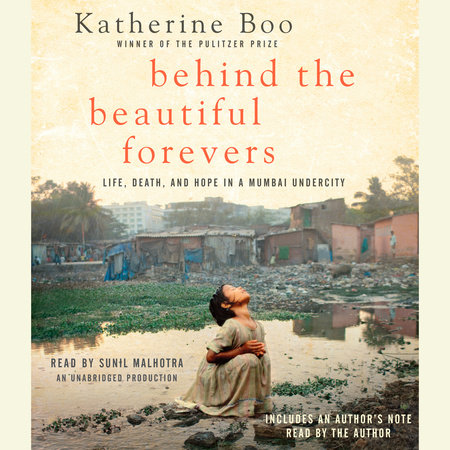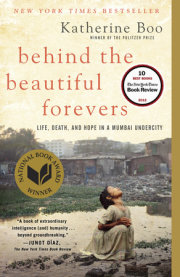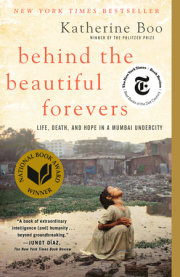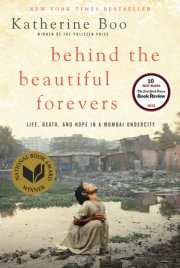1.
Annawadi
LET IT KEEP, the moment when Officer Fish Lips met Abdul in the police station. Rewind, see Abdul running backward, away from the station and the airport, shirt buttons opening as he flies back toward his home. See the flames engulfing a disabled woman in a pink- flowered tunic shrink to nothing but a matchbook on the floor. See Fatima minutes earlier, dancing on crutches to a raucous love song, her delicate features unscathed. Keep rewinding, back seven more months, and stop at an ordinary day in January 2008. It was about as hopeful a season as there had ever been in the years since a bitty slum popped up in the biggest city of a country that holds one-third of the planet's poor. A country dizzy now with development and circulating money.
Dawn came gusty, as it often did in January, the month of treed kites and head colds. Because his family lacked the floor space for all of its members to lie down, Abdul was asleep on the gritty maidan, which for years had passed as his bed. His mother stepped carefully over one of his younger brothers, and then another, bending low to Abdul's ear. "Wake up, fool!" she said exuberantly. "You think your work is dreaming?"
Superstitious, Zehrunisa had noticed that some of the family's most profitable days occurred after she had showered abuses on her eldest son. January's income being pivotal to the family's latest plan of escape from Annawadi, she had decided to make the curses routine.
Abdul rose with minimal whining, since the only whining his mother tolerated was her own. Besides, this was the gentle-going hour in which he hated Annawadi least. The pale sun lent the sewage lake a sparkling silver cast, and the parrots nesting at the far side of the lake could still be heard over the jets. Outside his neighbors' huts, some held together by duct tape and rope, damp rags were discreetly freshening bodies. Children in school-uniform neckties were hauling pots of water from the public taps. A languid line extended from an orange concrete block of public toilets. Even goats' eyes were heavy with sleep. It was the moment of the intimate and the familial, before the great pursuit of the small market niche got under way.
One by one, construction workers departed for a crowded intersection where site supervisors chose day laborers. Young girls began threading marigolds into garlands, to be hawked in Airport Road traffic. Older women sewed patches onto pink-and-blue cotton quilts for a company that paid by the piece. In a tiny, sweltering plastic- molding factory, bare-chested men cranked gears that would turn colored beads into ornaments to be hung from rearview mirrors-smiling ducks and pink cats with jewels around their necks that they couldn't imagine anyone, anywhere, buying. And Abdul crouched on the maidan, beginning to sort two weeks' worth of purchased trash, a stained shirt hitching up his knobby spine.
His general approach toward his neighbors was this: "The better I know you, the more I will dislike you, and the more you will dislike me. So let us keep to ourselves." But deep in his own work, as he would be this morning, he could imagine his fellow Annawadians laboring companionably alongside him.
ANNAWADI SAT TWO hundred yards off the Sahar Airport Road, a stretch where new India collided with old India and made new India late. Chauffeurs in SUVs honked furiously at the bicycle delivery boys peeling off from a slum chicken shop, each carrying a rack of three hundred eggs. Annawadi itself was nothing special, in the context of the slums of Mumbai. Every house was off-kilter, so less off-kilter looked like straight. Sewage and sickness looked like life.
The slum had been settled in 1991 by a band of laborers trucked in from the southern Indian state of Tamil Nadu to repair a runway at the international airport. When the runway work was complete, they decided to stay near the airport and its tantalizing construction possibilities. In an area with little unclaimed space, a sodden, snake-filled bit of brushland across the street from the international terminal seemed the least-bad place to live.
Other poor people considered the spot too wet to be habitable, but the Tamils set to work, hacking down the brush that harbored the snakes, digging up dirt in drier places and packing it into the mud. After a month, their bamboo poles stopped flopping over when they were stuck in the ground. Draping empty cement sacks over the poles for cover, they had a settlement. Residents of neighboring slums provided its name: Annawadi-the land of annas, a respectful Tamil word for older brothers. Less respectful terms for Tamil migrants were in wider currency. But other poor citizens had seen the Tamils sweat to summon solid land from a bog, and that labor had earned a certain deference.
Seventeen years later, almost no one in this slum was considered poor by official Indian benchmarks. Rather, the Annawadians were among roughly one hundred million Indians freed from poverty since 1991, when, around the same moment as the small slum's founding, the central government embraced economic liberalization. The Annawadians were thus part of one of the most stirring success narratives in the modern history of global market capitalism, a narrative still unfolding.
True, only six of the slum's three thousand residents had permanent jobs. (The rest, like 85 percent of Indian workers, were part of the informal, unorganized economy.) True, a few residents trapped rats and frogs and fried them for dinner. A few ate the scrub grass at the sewage lake's edge. And these individuals, miserable souls, thereby made an inestimable contribution to their neighbors. They gave those slumdwellers who didn't fry rats and eat weeds, like Abdul, a felt sense of their upward mobility.
The airport district was spewing waste that winter, the peak season for tourism, business travel, and society weddings, whose lack of restraint in 2008 reflected a stock market at an all-time high. Better still for Abdul, a frenzy of Chinese construction in advance of the summer's Beijing Olympics had inflated the price of scrap metal worldwide. It was a fine time to be a Mumbai garbage-trader, not that that was the term passersby used for Abdul. Some called him garbage, and left it at that.
This morning, culling screws and hobnails from his pile, he tried to keep an eye on Annawadi's goats, who liked the smell of the dregs in his bottles and the taste of the paste beneath the labels. Abdul didn't ordinarily mind them nosing around, but these days they were fonts of liquid shit-a menace.
The goats belonged to a Muslim man who ran a brothel from his hut and considered his whores a pack of malingerers. In an attempt to diversify, he had been raising the animals to sell for sacrifice at Eid, the festival marking the end of Ramadan. The goats had proved as troublesome as the girls, though. Twelve of the herd of twenty-two had died, and the survivors were in intestinal distress. The brothelkeeper blamed black magic on the part of the Tamils who ran the local liquor still. Others suspected the goats' drinking source, the sewage lake.
Late at night, the contractors modernizing the airport dumped things in the lake. Annawadians also dumped things there: most recently, the decomposing carcasses of twelve goats. Whatever was in that soup, the pigs and dogs that slept in its shallows emerged with bellies stained blue. Some creatures survived the lake, though, and not only the malarial mosquitoes. As the morning went on, a fisherman waded through the water, one hand pushing aside cigarette packs and blue plastic bags, the other dimpling the surface with a net. He would take his catch to the Marol market to be ground into fish oil, a health product for which demand had surged now that it was valued in the West.
Rising to shake out a cramp in his calf, Abdul was surprised to find the sky as brown as flywings, the sun signaling through the haze of pollution the arrival of afternoon. When sorting, he routinely lost track of the hour. His little sisters were playing with the One Leg's daughters on a makeshift wheelchair, a cracked plastic lawn chair flanked by rusted bicycle wheels. Mirchi, already home from ninth grade, was sprawled in the doorway of the family hut, an unread math book on his lap.
Mirchi was impatiently awaiting his best friend, Rahul, a Hindu boy who lived a few huts away, and who had become an Annawadi celebrity. This month, Rahul had done what Mirchi dreamed of: broken the barrier between the slum world and the rich world.
Rahul's mother, Asha, a kindergarten teacher with mysterious connections to local politicians and the police, had managed to secure him several nights of temp work at the Intercontinental Hotel, across the sewage lake. Rahul-a pie-faced, snaggle-toothed ninth grader-had seen the overcity opulence firsthand.
And here he came, wearing an ensemble purchased from the profits of this stroke of fortune: cargo shorts that rode low on his hips, a shiny oval belt buckle of promising recyclable weight, a black knit cap pulled down to his eyes. "Hip-hop style," Rahul termed it. The previous day had been the sixtieth anniversary of the assassination of Mahatma Gandhi, a national holiday on which elite Indians once considered it poor taste to throw an extravagant party. But Rahul had worked a manic event at the Intercontinental, and knew Mirchi would appreciate the details.
"Mirchi, I cannot lie to you," Rahul said, grinning. "On my side of the hall there were five hundred women in only half-clothes-like they forgot to put on the bottom half before they left the house!"
"Aaagh, where was I?" said Mirchi. "Tell me. Anyone famous?"
"Everyone famous! A Bollywood party. Some of the stars were in the VIP area, behind a rope, but John Abraham came out to near where I was. He had this thick black coat, and he was smoking cigarettes right in front of me. And Bipasha Basu was supposedly there, but I couldn't be sure it was really her or just some other item girl, because if the manager sees you looking at the guests, he'll fire you, take your whole pay-they told us that twenty times before the party started, like we were weak in the head. You have to focus on the tables and the rug. Then when you see a dirty plate or a napkin you have to snatch it and take it to the trash bin in the back. Oh, that room was looking nice. First we laid this thick white carpet-you stood on it and sank right down. Then they lit white candles and made it dark like a disco, and on this one table the chef put two huge dolphins made out of flavored ice. One dolphin had cherries for eyes-"
"Bastard, forget the fish, tell me about the girls," Mirchi protested. "They want you to look when they dress like that."
"Seriously, you can't look. Not even at the rich people's toilets. Security will chuck you out. The toilets for the workers were nice, though. You have a choice between Indian- or American-style." Rahul, who had a patriotic streak, had peed in the Indian one, an open drain in the floor.
Other boys joined Rahul outside the Husains' hut. Annawadians liked to talk about the hotels and the depraved things that likely went on inside. One drug-addled scavenger talked to the hotels: "I know you're trying to kill me, you sisterfucking Hyatt!" But Rahul's accounts had special value, since he didn't lie, or at least not more than one sentence out of twenty. This, along with a cheerful disposition, made him a boy whose privileges other boys did not resent.
Rahul gamely conceded he was a nothing compared with the Intercontinental's regular workers. Many of the waiters were college-
educated, tall, and light-skinned, with cellphones so shiny their owners could fix their hair in the reflections. Some of the waiters had mocked Rahul's long, blue-painted thumbnail, which was high masculine style at Annawadi. When he cut the nail off, they'd teased him about how he talked. The Annawadians' deferential term for a rich man, sa'ab, was not the proper term in the city's moneyed quarters, he reported to his friends. "The waiters say it makes you sound D- class-like a thug, a tapori," he said. "The right word is sir."
"Sirrrrrrr," someone said, rolling the r's, then everyone started saying it, laughing.
The boys stood close together, though there was plenty of space in the maidan. For people who slept in close quarters, his foot in my mouth, my foot in hers, the feel of skin against skin got to be a habit. Abdul stepped around them, upending an armful of torn paper luggage tags on the maidan and scrambling after the tags that blew away. The other boys paid him no notice. Abdul didn't talk much, and when he did, it was as if he'd spent weeks privately working over some little idea. He might have had a friend or two if he'd known how to tell a good story.
Once, working on this shortcoming, he'd floated a tale about having been inside the Intercontinental himself-how a Bollywood movie called Welcome had been filming there, and how he'd seen Katrina Kaif dressed all in white. It had been a feeble fiction. Rahul had seen through it immediately. But Rahul's latest report would allow Abdul's future lies to be better informed.
A Nepali boy asked Rahul about the women in the hotels. Through slats in the hotel fences, he had seen some of them smoking-"not one cigarette, but many"-while they waited for their drivers to pull up to the entrance. "Which village do they come from, these women?"
"Listen, idiot," Rahul said affectionately. "The white people come from all different countries. You're a real hick if you don't know this basic thing."
"Which countries? America?"
Rahul couldn't say. "But there are so many Indian guests in the hotels, too, I guarantee you." Indians who were "healthy-sized"-big and fat, as opposed to stunted, like the Nepali boy and many other children here.
Rahul's first job had been the Intercontinental's New Year's Eve party. The New Year's bashes at Mumbai's luxury hotels were renowned, and scavengers had often returned to Annawadi bearing discarded brochures. Celebrate 2008 in high style at Le Royal Meridien Hotel! Take a stroll down the streets of Paris splurging with art, music & food. Get scintillated with live performances. Book your boarding passes and Bon Voyage! 12,000 rupees per couple, with champagne. The advertisements were printed on glossy paper, for which recyclers paid two rupees, or four U.S. cents, per kilo.
Rahul had been underwhelmed by the New Year's rituals of the rich. "Moronic," he had concluded. "Just people drinking and dancing and standing around acting stupid, like people here do every night."
"The hotel people get strange when they drink," he told his friends. "Last night at the end of the party, there was one hero-
good-looking, stripes on his suit, expensive cloth. He was drunk, full tight, and he started stuffing bread into his pants pockets, jacket pockets. Then he put more rolls straight into his pants! Rolls fell on the floor and he was crawling under the table to get them. This one waiter was saying the guy must have been hungry, earlier- that whiskey brought back the memory. But when I get rich enough to be a guest at a big hotel, I'm not going to act like such a loser."
Copyright © 2012 by Katherine Boo. All rights reserved. No part of this excerpt may be reproduced or reprinted without permission in writing from the publisher.











